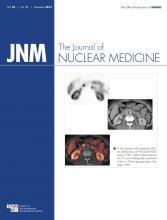Abstract
The aim of this study was to investigate the effects of the point-spread function (PSF) and time-of-flight (TOF) on improving 18F-FDG PET/CT images in relation to reconstruction parameters and noise-equivalent counts (NEC). Methods: This study consisted of a phantom study and a retrospective analysis of 39 consecutive patients who underwent clinical 18F-FDG PET/CT. The body phantom of the National Electrical Manufacturers Association and International Electrotechnical Commission with a 10-mm-diameter sphere was filled with an 18F-FDG solution with a 4:1 radioactivity ratio compared with the background. The PET data were reconstructed with the baseline ordered-subsets expectation maximization (OSEM) algorithm, with the OSEM+PSF model, with the OSEM+TOF model, and with the OSEM+PSF+TOF model. We evaluated image quality by visual assessment, the signal-to-noise ratio of the 10-mm sphere (SNR10 mm), the contrast of the 10-mm sphere, and the coefficient of variance in the phantom study and then determined the optimal reconstruction parameters. We also examined the effects of PSF and TOF on the quality of clinical images using the signal-to-noise ratio in the liver (SNRliver) in relation to the NEC in the liver (NECliver). Results: In the phantom study, the SNR10 mm was the highest for the OSEM+PSF+TOF model, and the highest value was obtained at iteration 2 for algorithms with the TOF and at iteration 3 for those without the TOF. In terms of a postsmoothing filter full width at half maximum (FWHM), the high SNR10 mm was obtained with no filtering or was smaller than 2 mm for algorithms with PSF and was 4–6 mm for those without PSF. The balance between the contrast recovery and noise is different for algorithms with either PSF or TOF. A combination of PSF and TOF improved SNR10 mm, contrast, and coefficient of variance, especially with a small-FWHM gaussian filter. In the clinical study, the SNRliver of the low-NECliver group in the OSEM+PSF+TOF model was compared with that of the high-NECliver group in conventional OSEM. The PSF+TOF improved the SNRliver by about 24.9% ± 9.81%. Conclusion: A combination of PSF and TOF clearly improves image quality, whereas optimization of the reconstruction parameters is necessary to obtain the best performance for PSF or TOF. Furthermore, this combination has the potential to provide good image quality with either lower activity or shorter acquisition time, thus improving patient comfort and reducing the radiation burden.
Footnotes
Published online Sep. 4, 2012.
- © 2012 by the Society of Nuclear Medicine and Molecular Imaging, Inc.







